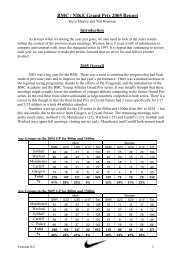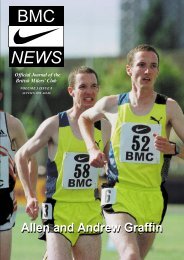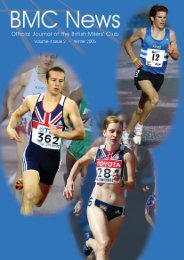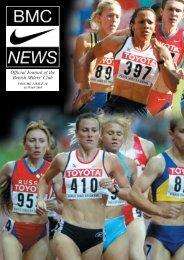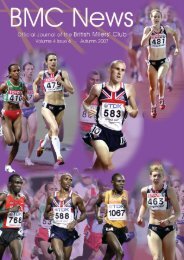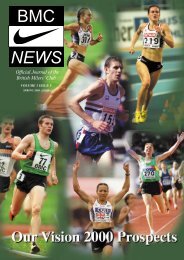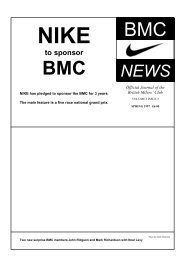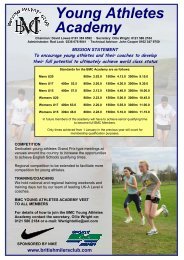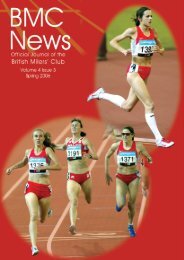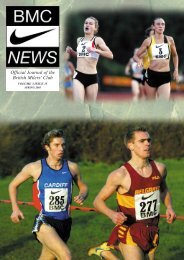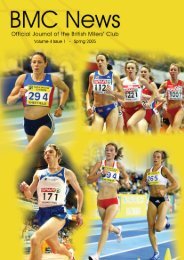BMC NEWS - British Milers Club
BMC NEWS - British Milers Club
BMC NEWS - British Milers Club
You also want an ePaper? Increase the reach of your titles
YUMPU automatically turns print PDFs into web optimized ePapers that Google loves.
"Split Times" tables<br />
by Tony Elder<br />
As a coach I find these Split Times<br />
tables very useful, so I thought other<br />
coaches and athletes might also find<br />
them of use.<br />
Training:<br />
1<br />
. When athletes are attempting to run<br />
even pace 400s, 600s or 800s for<br />
example, it is important to know what the<br />
intermediate times should be. Many coaches<br />
will know these anyway, but I find that<br />
occasionally – on a coaching course for<br />
instance or when a young athlete arrives to<br />
do some training or when planning training<br />
targets for the months ahead – it is helpful to<br />
be able to refer to these sheets.<br />
2<br />
. If an athlete wants to reduce their<br />
1500m time from, say, 4:15 to as close to<br />
4:00 as possible, it is useful to be able to<br />
quickly check that this means that race pace<br />
400s in training will have to be done faster<br />
than 68 and that progression to 400s in 66<br />
and then 64 is recommended if not essential.<br />
Likewise 600s in 102 are now too slow. 99 or<br />
96 must be the target. For 800s at race pace –<br />
forget 2:16! Think 2:12, 2:10 and 2:08.<br />
Frank’s 4 Second Rule:<br />
<strong>BMC</strong> members will, I’m sure, be familiar<br />
with Frank Horwill’s 4 second rule! Top<br />
class male middle distance runners should<br />
have about 4 seconds difference per 400m in<br />
their best times for 400m, 800m, 1500m and<br />
3000m. For females the differential is about<br />
5 seconds. The same principle applies to<br />
those whose standards are more modest and<br />
to younger athletes, though the differential<br />
will be greater e.g. 6 or even 7 seconds.<br />
Two examples:<br />
Steve Ovett’s best times were 400:<br />
(1) 47.5; 800: 1:44.09 (52 per 400);<br />
1500: 3:30.77 (56 per 400); 3000: 7:41.3<br />
(61.5 per 400). His 800 and 1500 times are<br />
closest to the 4 seconds differential – spot<br />
on! – probably because these were the<br />
distances he raced most often.<br />
At the <strong>BMC</strong>’s training weekend for<br />
(2) young athletes at Ardingly last April,<br />
I used Zoe Jelbert’s (then) best times to illustrate<br />
this principle. Chris Wooldridge’s<br />
young 16 year old protégé had, at that time,<br />
the following pbs: 800: 2:12.33 (66.16 per<br />
400); 1500: 4:28.3 (71.6 per 400); 3000:<br />
9:37.54 (77 per 400) giving differentials of<br />
5.44 and 5.40.<br />
The principle is that whatever your<br />
standard, you should have a consistent differential<br />
per 400m in your times at 400, 800,<br />
1500 and 3000. The tables are very useful in<br />
helping athletes see where their weaknesses<br />
lie and in helping the coach confirm that<br />
either all is well or that more speed work or<br />
more aerobic work is required.<br />
Training and the 5-pace system<br />
Assuming you are a middle distance<br />
runner who is seriously intent upon<br />
progressing year on year until you are ranked<br />
in GB and then in the World…in other words<br />
you aspire to a medal in the Olympics in<br />
2004, 2008 or 2012…then you and your<br />
As your times improve – at<br />
one distance – so you need to<br />
revise your targets and your<br />
training too for other<br />
distances.<br />
coach will almost certainly want to base your<br />
training on the 5-pace system. Again as all<br />
readers of <strong>BMC</strong> News will know, one hopes,<br />
this means training at different paces or<br />
speeds. As a 1500 runner you cannot afford<br />
to ignore training at 800 pace and faster, as<br />
well as at 3000/5000 pace and slower, as well<br />
as training at 1500 race pace. But how are<br />
you to know what pace is right for you The<br />
answer is to use the "Split Times" tables, and<br />
of course the 4 or 5 or 6 second rule.<br />
Maybe you are a young female runner who<br />
can run 2:12 for 800m. If you use the tables<br />
and assume a 6 second differential, then you<br />
find your 1500 training pace will be at 72 per<br />
lap (e.g. some 500s in 90 seconds), your<br />
3000 pace is 78 per lap (e.g. some 1000s in<br />
3:15). Also your faster than race pace<br />
training will be at 60 second 400 pace (e.g.<br />
some 200s in 30 seconds) or faster. You will<br />
also be running at 800 pace (e.g. some 300s<br />
in 49.5) Then there are the aerobic sessions<br />
lasting anything from 30-60 minutes - not<br />
slow, but not as fast as 3K pace fairly<br />
obviously. Naturally the recovery period and<br />
how many you do and how often are all<br />
important. But the tables can be used to work<br />
out either how fast in training you ought to<br />
be running, or what a particular training<br />
session means in terms of the 5-pace system.<br />
As your times improve – at one distance –<br />
so you need to revise your targets and your<br />
training too for other distances. This is where<br />
the tables come in. And they can be used for<br />
a wide range of athletic performers, from the<br />
11:15 3000m runner – who should be able to<br />
run an 800 in around 2:30 - to the 1:40 800m<br />
runner (have we got any of these!)<br />
World Records and World Class Performers<br />
Using the tables one can have some interesting<br />
thoughts about some of the world’s<br />
leading performers and about the current<br />
world records. Svetlana Masterkova has pbs<br />
of 1:55.87 for 800m (57.9 per 400) and<br />
3:56.77 for 1500m (63.1 per 400).<br />
Differential 5.2 seconds. If Masterkova had a<br />
differential of 5 seconds and ran her 1500 at<br />
62.9 pace she would improve her 1500 pb to<br />
3:55.9. Gabriela Szabo has a similar 1500 pb<br />
to Masterkova: 3:56.97. Could she run an<br />
800 in 1:56 Or could Masterkova run 8:24<br />
for 3K Wilson Kipketer has pbs of 46.85<br />
(400) and 1:41.1 for 800m (50.55 pace).<br />
Differential 3.7 seconds. But his 1500m pb is<br />
3:42.80 (59.4 pace!) Differential of 8.85! He<br />
is probably quite satisfied with his successes<br />
at 800m to worry about running fast 1500s,<br />
but what if Michael Johnson is of course a<br />
200/400m specialist (just as Kipketer is an<br />
800m specialist) but what could he do for<br />
800m with a 400 pb of 43.18 You can check<br />
the tables to work it out! [Even with the<br />
speed/endurance equation, it’s interesting.]<br />
Men’s World Record 800m pace (1:41.1)<br />
is 50.55 per 400. If the 4 second rule is<br />
applied, we would expect the 1500m World<br />
Record to be run at 54.55 pace which equates<br />
to 3:24.56 – over a second faster than the<br />
present world record. Watch this space!<br />
I hope that many coaches and athletes find<br />
the Split Times tables useful.<br />
22<br />
<strong>BMC</strong> News : Spring 2001



